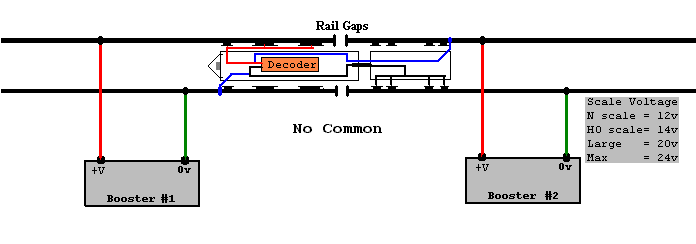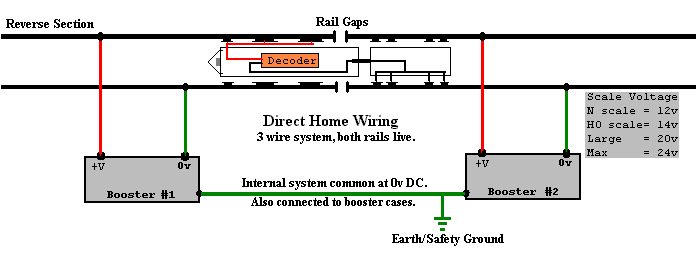

With no common on the system, there is no reference between boosters. So the Loco is stalled, the decoder sees 0v. Unless the "Optional Wipers" are installed. Now they will supply the needed reference and put the boosters in parallel. If one side of the gaps happen to be a reverse section and of opposite polarity/phase, the "Wipers" will create a short between boosters and either autoreverse on of the boosters, or hold the short.

Common rail entering a reverse section of opposite polarity/phase. As the Loco first entered the reverse section, the wheels crossing the gaps on the tops of the rail should short out one or both of the boosters. But lets assume dirt delayed the short and momentum and flywheel has coasted the Loco to this position. It can and does happen. With the Loco in this position, follow the arrows, you will see there is no reference to the common rail on the Loco pickups. This places the boosters in series and the decoder will see (+V x 2)= not good. Pending the +V and decoder, this can result in a blown decoder. Adding the "Optional Wipers", needed by some boosters to autoreverse, will short out both boosters, as long as they make contact with the rails (dirt, etc), make the boosters/modules autoreverse or hold the short.
Note:
Any Loco position that allows both sides of the pickups
to connect across both boosters and not the common rail can allow the decoder
to see double +V,. Such as a derailment across parallel tracks, improperly
aligned crossovers, etc.

Direct home wiring. The common reference is supplied by an internal system common at 0v DC. Here the common is not connected to either rail and will flow seamlessly right through double gaps, reverse sections, ect. As the Loco crosses the gaps, a short on either rail can reverse a autoreversing booster, no "Optional Wipers" needed. Most important if the Loco should coast to this position, pending on the polarity/phase of the boosters, there is only two possible voltages that the decoder can see 0v or +V. No sneak paths to allow the boosters to parallel, double their voltages. If you measure the voltage from system common to the rails, you will find both have a voltage, but phase shifted 1/2 bit width.
Note:
By connecting the system common to a earth ground,
you not only supply common sense safety but also help reduce static build
up on the entire system. Common rail should never be connected between booster
districts, but a common return can be used within a booster district.
[JDB: Another way to accomplish this function is with a common raw power source (DC or AC supply feeding the boosters). However, the requirements on amperage of one common transformer can be costly and inconvenient. If your system allows the common path on the transformer secondary, you may be able to take advantage of this configuration (using seperate transformers) even if your brand did not provide a "system common" connection point.]
Last updated April 14, 1998